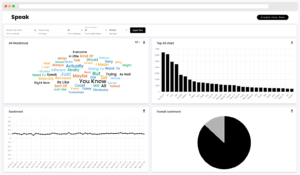
How to Transcribe a Recording to Text
How to Transcribe a Recording to Text Our no-code transcription tool enables you to convert an audio recording to text in only two steps. Find

Sentiment analysis is when you extract emotions and feelings from a given text. This allows organizations to understand the underlying meanings behind a message which can be quite well-hidden. But how exactly does sentiment analysis work and should your business use it?
Before diving into how sentiment analysis works, let’s take a look at how powerful sentiment analysis can be when leveraged the right way.
We all remember that Nike Colin Kaepernick campaign right? The one that caused arguments during thanksgiving and was probably responsible for a number of broken friendships?
Well if you don’t, here’s a quick recap.
In 2018, Nike introduced a marketing campaign featuring Colin Kaepernick, a controversial figure for some, that sparked a nationwide social media firestorm.
In the 12 months before Nike announced the Kaepernick ad, Nike averaged a net positive sentiment of 26.7% on social media. However, Nike’s net sentiment plummeted to -4.7% after the announcement.
If you were the head of marketing for Nike, you’d immediately pull the plug on the campaign, right? So why didn’t they?
Despite the seemingly negative reception on the surface level, Nike reported an increase in sales by 31% and an explosion in brand mentions by 2,677%.
Nike leveraged sentiment analysis to realize that beneath that wave of negative sentiment was some unreported positive sentiment from their target customers – consumers that matter to them. Nike accepted the gamble, continued with the ad, and the results spoke for themselves.
Sentiment analysis, also known as opinion mining, refers to the extraction of emotions (happy, angry), intentions (query, complaint, opinion, etc.), and positivity (negative, neutral, positive) from text.
Common uses of sentiment analysis include reputation management, social media monitoring, market research, and customer feedback analysis. Sentiment analysis is also a subset of natural language processing (NLP) - using AI and computers to study linguistics.
It’s common to see the terms sentiment analysis, text analytics, and natural language processing (NLP) used together. While all these are related terms in data science and may have the same practical applications, they do not mean the same thing.
Sentiment analysis: As mentioned, sentiment analysis refers to assigning sentiment scores (positive, negative, or neutral) to texts via machine algorithms. Sentiment analysis is also known as opinion mining.
Text analytics: Also known as text mining, text analytics refers to analyzing unstructured data and extracting information from it such as generating word clouds. Text analysis usually accompanies sentiment analysis due to its similar nature.
Natural language processing (NLP): Natural language processing is a field in computer science that’s concerned with using computers to analyze human language. You can think of natural language processing as a superset of sentiment analysis and text analytics.
There are five main types of sentiment analysis, each focusing on different aspects of a dataset:
Emotion detection aims to recognize emotions through words in a given text, such as happy, disappointment, anger, and fear.
There are several ways to detect emotion in text. The most common is identifying keywords and assigning them emotions based on a lexicon (a list of words and their associated feelings).
Aspect-based sentiment analysis (ABSA), also known as feature-based sentiment analysis, is the process of recognizing pre-determined aspects and their associated sentiments in a dataset.
These aspects vary from organization to organization, with the most common being price, packaging, design, UX, and customer service.
ABSA is most commonly used in products and services reviews to determine which features customers liked or disliked most. Then, organizations can hone in on specific areas of their products and services that require improvement.
Fine-grained sentiment analysis breaks down sentences into parts and extracts the sentiment from those individual parts. The sentiment is then categorized into one of five polarity categories: very positive, positive, neutral, negative, very negative.
Polarity precision is instrumental in interpreting customer feedback rating scales. For instance, on a 1-5 star rating scale, 1 would be very negative, whereas 5 would be very positive. On a 1-10 rating scale, 1-2 would be very negative, while 9-10 is very positive.
Coarse-grained sentiment analysis is similar to fine-grained sentiment analysis. However, coarse-grained sentiment analysis is different because it extracts sentiment from overall documents or sentences rather than breaking down sentences into different parts.
Coarse-grained sentiment analysis classifies sentiment into only three polarity categories: positive, neutral, negative.
Multilingual sentiment analysis allows you to collect data from non-English texts without translating them. Relying on translations in multilingual analyses may be convenient, but it is unreliable because linguistic nuances such as semantics and lexicons may get mixed up.
It’s easy to forget, but only 17% of the world population speaks English, and English represents only 25.9% of Internet users. Multilingual sentiment analysis allows you to tap into that missing majority and maximize value for your business.
Rather than identifying sentiment, intent analysis examines textual cues for intention and classifies them into predetermined tags. These tags are heavily dependent on your business needs and aren’t one-size-fits-all.
For example, intent classifiers for social media messages can be separated into suggestion, query, complaint, feedback, and marketing. Whereas more appropriate tags for analyzing customer feedback include interested, disinterested, subscribe, and unsubscribe.
Sentiment analysis uses a mixture of natural language processing (NLP) techniques, statistics, and machine learning methods to determine sentiment in text and its polarity automatically.
The most common sentiment analysis models include rule-based, machine learning, and hybrid.
In the rule-based approach, the algorithm assigns and calculates the sentimental score of text based on a human-crafted set of rules or lexicons (a list of words and their associated emotions).
The list already laid out the corresponding sentimental scores for both negative (awful, terrible, bad) and positive (good, awesome, delightful) words. Then, the algorithm identifies the polarized words and sums up the overall sentiment, usually on a scale of -1 to +1.
A good sentiment analysis model using the lexicon-based approach should incorporate the impact of each sub-text on the perceived intensity in sentence-level text. There are 5 factors that would affect the polarity of a sentence:
Punctuation, namely the exclamation point (!), increases the magnitude of the intensity without modifying the semantic orientation.
Capitalization, specifically using ALL-CAPS to emphasize a sentiment-relevant word in the presence of other non-capitalized words, increases the magnitude of the sentiment intensity without affecting the semantic orientation.
Degree modifiers (also called intensifiers, booster words, or degree adverbs) impact sentiment intensity by either increasing or decreasing the intensity. For example: “The weather is extremely hot.”
Polarity shift due to conjunctions, The contrastive conjunction “but” signals a shift in sentiment polarity, with the sentiment of the text following the conjunction being dominant. For example: “The weather is hot, but it is bearable.” has mixed sentiment, with the latter half dictating the overall rating.
Catching Polarity Negation by examining the contiguous sequence of 3 items preceding a sentiment-laden lexical feature, we catch nearly 90% of cases where negation flips the polarity of the text. For example, a negated sentence would be, “The weather isn't really that hot.”.
Initial investment of human effort: Building a rule-based sentiment analysis engine from scratch can be arduous. There are thousands of words in the English language, not to mention developing lexicons for multilingual sentiment analysis engines.
Subjectivity about agreeing on polarity: Disagreements between the valence of a word can also affect the final results. For example, if another researcher assigns the same sentimental score to atrocious as you would to bad, what should the overall sentiment score be?
Unable to detect context: The rule-based sentiment approach may not detect sarcasm and context. For example, “THAT Jack is the team lead? I’m sureee he’ll do a great job and won’t screw things up 😂😂 ” may produce a positive sentiment score despite being a sarcastic, negative insult.
In the machine learning approach, the sentiment analysis engine is trained to automatically classify text data with the correct tags. The training (supervised and unsupervised machine learning) is usually done by feeding the engine tons of pre-tagged text data.
Through continuous feeding of pre-tagged examples, the machine can then learn linguistics as a human would and accurately predict tags of future data sets (e.g., that song was lit lol -> positive)
Investment of time and resources: Training a machine-learning algorithm to reach satisfactory accuracy levels can take a long time. Obtaining sufficient data sets to feed the engine can also be costly.
Susceptible to errors: Machine learning systems can also be inaccurate such as when fed biased or inaccurate datasets.
The hybrid approach combines both machine learning and rule-based sentiment analysis to produce more accurate results. However, models that use the hybrid approach involve the most upfront capital and maintenance costs.
Since the advent of the Internet in the 1990s, consumer and social media platforms have evolved and become increasingly intertwined with our daily lives. As the number of Internet users is expected to grow to 5.3 billion by 2023 (6% CAGR), you cannot overlook the vast value of online data.
Businesses also cannot ignore social media’s influence on consumers’ purchase decisions. According to GlobalWebIndex, 54% of people with social media accounts utilize social media to research products.
Moreover, social media users and opinion leaders are voicing opinions about brands, politics, and human rights issues. These user-generated content are major influences of consumer behavior because customers rely on word-of-mouth more than advertising messages.
With sentiment analysis, businesses can stop passively reacting to public opinion and take proactive steps in shaping general sentiment towards their brand. Sentiment analysis allows businesses to find out what consumers are saying and also the meaning behind those messages.
Sentiment analysis tools allow you to analyze thousands, if not, millions of online text in a click. Instead of examining individual tweets or Facebook posts, business owners can have an immediate overview of how consumers feel about their brand.
Moreover, sentiment analysis is automatic, saving labor costs and time spent collecting data.
Sentiment analysis goes beyond what customers are saying, they provide insights into why customers have those opinions. By mining opinions for their intentions and polarity, businesses can identify areas to improve that they may have never realized.
Sentiment analysis also allows you to make data-backed decisions for more informed decision-making. Without reliable data to base your decisions on, you’d be shooting in the dark and ultimately waste time and money.
Sentiment analysis provides ample opportunities for real-time marketing – marketing messages crafted spontaneously. With data being reported to you in real-time, sentiment analysis allows you to capitalize on trending events or even manage PR crises before they grow into a major issue.
Sentiment analysis can also analyze vast amounts of unstructured data at scale—for example, comments, messages, images, and even videos. You can even integrate certain sentiment analysis APIs with customer relationship management (CRM) software to mine opinions from customer feedback in real-time.
Sentiment analysis is, in essence, finding out how people feel about a particular topic. This technology has applications in corporations, NGOs, political parties, and even countries. After all, understanding people’s inner sentiments allows researchers to understand their needs better.
Social listening refers to monitoring social media mentions about a brand or topic related to your company. Rather than collecting massive amounts of social media posts that mention your business, sentiment analysis takes it one step further and highlights why they made those comments.
You can also conduct opinion mining on your competitors and find out how people feel about their brand and its products and services. Furthermore, all these analyses are happening in real-time, allowing you to conduct more agile marketing strategies.
You can integrate a sentiment analysis API with Twitter to mine opinions about a particular topic. In this study by Abdur Rasool et al., machine learning sentiment analysis was conducted on Adidas and Nike by mining texts from Twitter. Their overall sentiment score was calculated with machine learning techniques before being compared.
The results showed that Nike and Adidas had similar sentiment distribution – an overall positive sentiment with the majority being neutral. However, Adidas had a slightly higher positive sentiment than Nike (27.2% vs. 24.5%). This could either be a great or bad sign, depending on which company you’re working for.
Depending on your sentiment analysis tool, you can pinpoint users with neutral and negative sentiments to convert them into positive brand ambassadors. Overall, sentiment analysis provides you with information to make informed decisions to improve your brand image.
Depending on the size of your company, there may be hundreds or even thousands of social media mentions involving your brand every day. Some of these may be queries, complaints, or other negative messages.
Lack of or slow social media engagement may result in losing loyal customers and their customer lifetime value. Worse yet, they may spread negative word-of-mouth and deter other people from buying from you.
If such a PR crisis emerges, sentiment analysis tools will help you manage them before they grow too large.
In 2014, Expedia Canada launched their “Escape Winter: Fear” Christmas ad. In it, a father was terrified by what he thought was the violent snowstorm outside but was actually the screeching sound of his daughter practicing the violin.
The obnoxiously loud and off-key screeches became unbearable after several airings. The ad was even played during the World Junior Hockey Championships, which wasn’t well-received.
Many Canadians flocked to social media to criticize the ad’s awful sound choice, with comments going as far to say “Worst commercial, it is sooooooooooooooo overplayed that it becomes annoying, and I will probably not use expedia simply because this commercial is so damn annoying.”
Expedia Canada immediately responded to the negative sentiment by halting the ad and releasing two sequels. One of them had the same father throwing the violin out of the house. In the other sequel, Expedia invited an actual social media user who commented about the first ad to smash the violin into pieces.
As shown by Expedia Canada, sentiment analysis allows you to convert embarrassing mishaps or PR crises into marketing opportunities and as a result, increase brand awareness.
Since sentiment analysis is concerned with understanding consumers’ attitudes and opinions, it’s common to pair it with market research. Opinion mining usually occurs at the interpretation and analysis stage of the marketing research process.
More specifically, market researchers mine opinions from data sets collected through focus groups and interviews. By digging deeper into why your research participants said what they said, you can discover their exact problems, needs, and wants.
Few data transcription and data collection software come with sentiment analysis tools, and that’s one way we differentiate ourselves. With Speak, you can produce transcriptions at scale and analyze these precise data sets with text and sentiment analysis tools – all in one centralized media database.
If you’d like to know more about how Speak can optimize your workflow processes and increase research ROI, register for our 7-day trial with no credit card required.
Qualitative research is a type of market research that focuses on obtaining subjective information. Unlike quantitative research, qualitative data collects non-quantifiable data such as opinions, attitudes, and perceptions towards a subject.
A major part of any market research involves transcribing data from interviews for further analyses. Since the focus is on subjective opinions, the answers given can be quite lengthy.
Even market research for small businesses may involve analyzing dozens of qualitative data sets. Assuming you interviewed 50 participants with each session lasting 30 minutes, you’re looking at 25 hours of recordings to review.
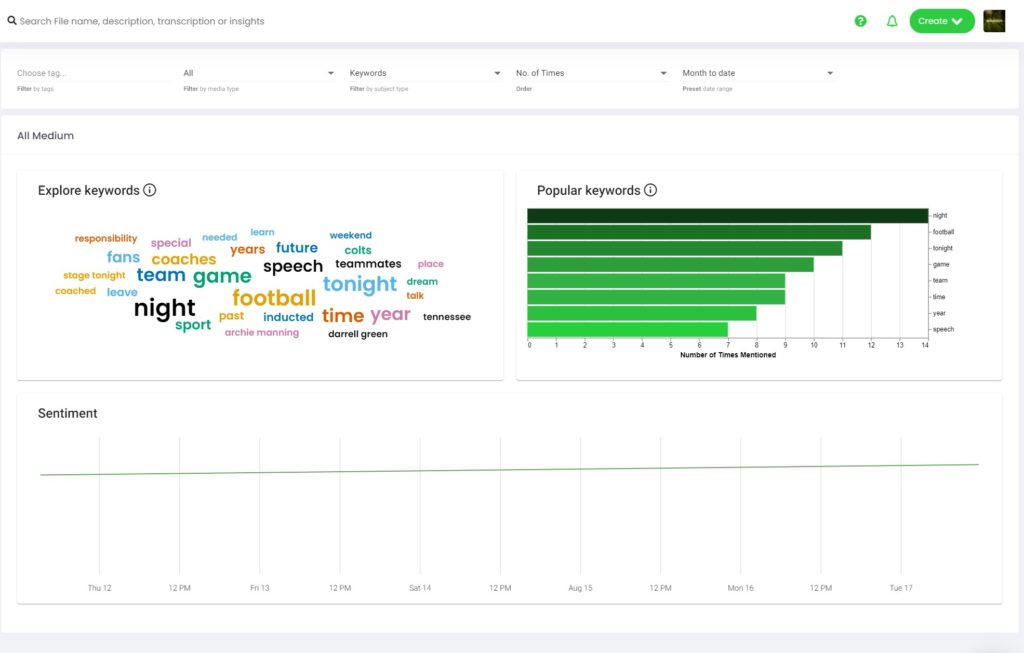
Sentiment analysis speeds up that process by analyzing the data sets and producing the sentiment scores at scale. Speak’s insights dashboard also generates prevalent keywords and topics from any market research to get an overview of key areas to pay attention to.
This allows you to quickly identify key areas that may require improvements. For more precise analyses, Speak’s dashboard also reports the sentiments of individual sentences, allowing you to hone in on specific areas that may require improvement.
Word clouds are a great way to highlight the most important words, topics and phrases in a text passage based on frequency and relevance. Generate word clouds from your text data to create an easily understood visual breakdown for deeper analysis. Try our free word cloud generator today to automatically visualize insights from your data.
Robust customer service is imperative for any business. According to a study done by Twitter, users expect brands to respond within an hour. One hour is a short time to address tons of customer queries, not to mention if they made the query during non-business hours.
Furthermore, answering a complaint on social media can increase customer advocacy by as much as 25%.
Customer relationship management (CRM) software allows you to respond to customer queries immediately. When paired with sentiment analysis API, you can analyze customer interactions at scale and determine how customers feel about your products & services.
Sentiment analysis also sheds light on unnoticed issues in your products and services. With aspect-based sentiment analysis, you can identify which features to improve on or maintain.
Overall, your product is the most important element of the marketing mix, and sentiment analysis helps you to take your products’ quality to greater heights.

Adobe is an extensive suite of software loved by creatives worldwide. Some of its notable tools include Adobe XD (UI/UX design), Adobe Photoshop (graphics editor), and Adobe Lightroom (photo editor). The Twitter customer service of Adobe XD in particular, it is so impressive that Twitter commended them on their blog.
By proactively responding to customer queries, Adobe XD (and other Adobe Twitter accounts) have successfully created a close-knit community of creatives on Twitter.
For instance, @AdobeXD has almost 120 thousand followers, an impressive amount but is still dwarfed by Adobe’s other Twitter accounts, @Lightroom (1.8 million followers) and @Photoshop (3.2 million followers).

Adobe’s general customer service Twitter account, @AdobeCare, actually scours Twitter for mentions of topics that may be related to their company, in this case, photoshop. As you may have noticed, the customer never actually tagged AdobeCare themselves.
However, through proactive sentiment analysis and social listening software, AdobeCare manages to respond to customer inquiries at impressive speeds.
Sentiment analysis also has applications in finance, particularly among investors and day traders. Investors frequently monitor the market sentiment - the general sentiment of investors towards a financial market or company.
Financial markets are volatile and always change unexpectedly to the demise of newbie day traders hoping to get rich quickly. Seasoned investors would utilize trading psychology to analyze market sentiment factors and make profitable trades.
The two main factors influencing this volatility are news events (politics, new laws, industry-related, company earnings) and social media comments.
By harnessing sentiment analysis tools, investors can know the general sentiment of a financial market in real-time and make predictions about equity price changes.

For example, after social media influencer Kylie Jenner posted this tweet, the share price of SNAP dropped by 7%, which translated to losses of $1.3 billion in market value. At the time, Kylie Jenner had 39 million followers, so it’s no wonder that a single tweet had such a significant impact on market sentiment and share prices.
A sentiment analysis software would immediately report a sudden drop in sentiment, providing investors sufficient time to sell shares before prices plummet further.
Politicians and governmental bodies often use sentiment analysis to mine opinions from the general public, voters, and even competitors. With sentiment analysis, you can instantly extract pain points from millions of citizens and address them for political support.
As part of President Barack Obama’s 2012 reelection campaign, Obama for America utilized sentiment analysis tools to mine 5.7 million messages from the campaign’s website. The algorithm tagged words from inquiries such as polling or contribution based on pre-given lexicons (a list that assigns a sentiment with any given word).
Malaysia, a member of ASEAN (Association of Southeast Asian Nations) held its 14th general election in 2018. The ruling party had always been Barisan Nasional, the main coalition of right-wing and centrist parties.
However, Pakatan Harapan (the coalition of center-left parties) miraculously won the 14th general election and defeated Barisan Nasional in a landslide victory. There were mixed feelings because this would be the first time in 61 years that Malaysia would be governed by another party.
Several researchers conducted sentiment analysis on citizens’ acceptance towards the new ruling party based on the Naive Bayes Method (a probabilistic method). These researchers extracted tweets and relevant hashtags for a month before calculating the overall sentiment.
It turns out that public sentiment towards the Pakatan Harapan was 30% positive, 41% neutral, and 29% negative – barely positive.
The new government quickly got to work and analyzed public sentiment again after 100 days of office. After surveying 487,000 respondents, results showed that public sentiment was “more positive than negative”, with negative sentiments leaning towards transportation and corruption.
Thus, sentiment analysis creates opportunities not just for corporations but also for governments to serve peoples’ needs better. Without sentiment analysis, you may ignore underlying issues and lose out on revenue, public support, or other metrics relevant to your organization.
When it comes to sentiment analysis tools, you have three options: build it yourself, buy ready-made software, or have it custom-built by a vendor. Regardless, there are several questions you should ask yourself before choosing a sentiment analysis tool.
Firstly, how complex should the algorithms be? There are various types of sentiment analysis software, each using different techniques to analyze text. More advanced tools can recognize sarcasm, emoticons, and other linguistic nuances more accurately but involve higher costs.
Next, do you get a trial? The best way to implement sentiment analysis in your business is to try it for yourself. Different sentiment analysis models have varying accuracy and may not be trained for your specific need.
Also, ask yourself if the sentiment analysis tool fits within your project’s scope and budget. Comprehensive sentiment analysis software would require higher initial capital and maintenance costs. Be it analyzing tweets or customer feedback, choose a solution that fits your business goals to maximize ROI.
Finally, are there any value-added services? An effective sentiment analysis software combines various text analysis tools for a more holistic analysis of text data. There should also be a sentiment analysis API that you can integrate into your CRM or other marketing software in your stack.
Since sentiment analysis is such a complex process, you have to pay for most options. Some platforms include trials to let you test out the platform before committing since these tools can be expensive - costing hundreds and even thousands per year.
Of course, these costs are negligible if you’re in a large company. But what if you’re just starting out or you simply want to experiment with sentiment analysis tools’ capabilities?
At Speak, we offer an all-in-one solution for data transcription, sentiment analysis, and API integrations. We also allow users to use all our analysis tools for free – sentiment analysis, entity recognition, and word cloud maker to identify prevalent keywords.
We also provide a 7-day trial with no credit card required if you want to experiment further. To gain access to our whole suite of tools, all you need to do is sign up for free!
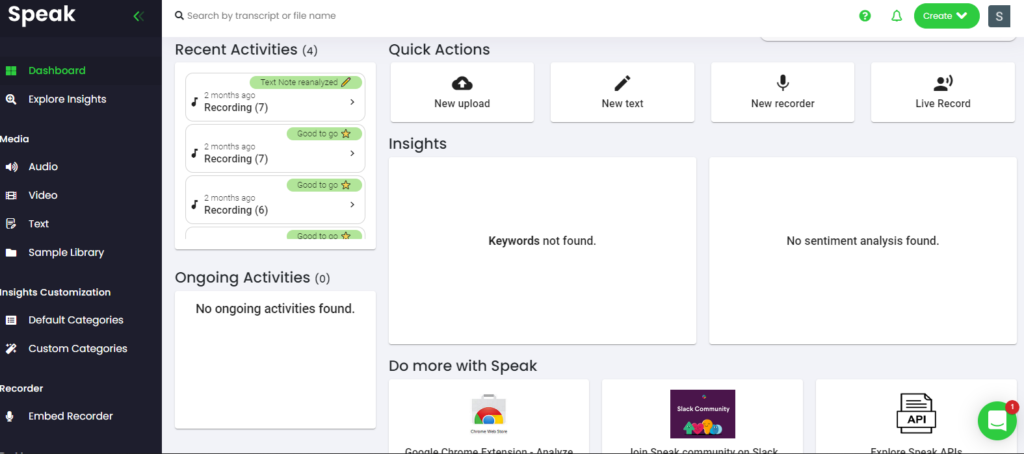
If you’d like to use sentiment analysis for your organization, we have various plans starting from only $19.99 a month. We also have custom solutions to fit your specific needs and make it easy to scale your research and analysis efforts.
If you’d like to learn more, contact us and we’ll help you improve business revenue, increase brand awareness, and optimize workflows all with sentiment analysis.
There are many pre-made sentiment analysis engines (like Speak) usually in the form of SaaS (Software as a Service). On the other hand, you can build your own sentiment analysis solutions with open source libraries and by following the tutorials below.
Deciding between buying or building a sentiment analysis tool primarily involves cost, expertise, and time.
Buying a sentiment analysis solution saves time and doesn’t require computer science knowledge. These pre-trained models usually come with integrations with popular third-party apps such as Twitter, Slack, Trello, and other Zapier integrations. Also, you don’t need to maintain these sentiment analysis engines because your vendor will do it for you.
On the other hand, building your own sentiment analysis model allows you to customize it according to your needs. If you have the time and commitment, you can teach yourself with online resources and build a sentiment analysis model from scratch.
We’ve provided helpful resources and tutorials below if you’d like to build your own sentiment analysis solution or if you just want to learn more about the topic.
Pros
✅ Cheaper
✅ Saves time and effort
✅ Comes with API and Zapier integrations
✅ You don’t need data science or coding knowledge
Cons
❌ May not be suitable for your specific needs
Pros
✅ Customized to your project scope and goals
✅ Simple sentiment analysis models can be done yourself
Cons
❌ Takes time to build and train the engine
❌ Involves upfront investment and maintenance costs
Sentiment analysis provides an overview of how people feel about a subject. However, it is not perfect and comes with several limitations. The main limitations of sentiment analysis are:
The term polarity in sentiment analysis refers to the degree to which a word or sentence is positive, negative, or neutral. It is easy to classify polarized words as either positive or negative. For instance, good indicates positive sentiment, whereas bad indicates negative sentiment.
However, the issue arises when deciding how positive a word or sentence should be. For example, “the food was atrocious” and “the food was extremely terrible” both clearly indicate negative sentiment, but placing a specific sentiment score is subjective to the analysis model and human annotator.
Overall, different people may assign different sentiment scores on the same sentence because sentiment is subjective.
People express opinions in a context, and removing that context would change the meaning of their words. Some of these contexts include using synonyms, ironic and sarcastic comments, memes, and even emoticons.
For example, “Why are you only doing this now?? 😠😠” clearly indicates negative sentiment. However, the sentiment would change entirely if this comment was, say, followed up with another message “That trash should’ve gotten what he deserved way earlier lmao”.
That follow-up message provides more context and changes the former sentence entirely. Suddenly, it’s not a negative complaint about delays - it’s a celebration of someone finally getting punished for their actions.
Many sentiment analysis models work by assigning a sentiment score to a specific word based on a predetermined list. But just because a sentence doesn’t contain any sentiment words doesn’t mean it doesn’t express sentiment and vice versa.
For example, “The Redmi guy told me that I should buy an iPhone instead of an android if I wanted an actual smartphone” doesn’t contain any polarized words and may produce a neutral sentiment score. However, the sentence clearly indicates negative sentiment towards android phones.
You have to train machine learning sentiment analysis models to correctly identify sarcasm, contexts, and other sentiment analysis challenges. The training involves feeding the engine tons of text documents to improve and learn just like a human would.
The downside is that the algorithm requires a long time and lots of feeding to achieve human-level accuracy. Any errors or inaccuracies in the data sets being fed to the machine would also cause it to learn bad habits and, as a result, produce inaccurate sentiment scores.
Cultures have their own dialects and even sub-dialects, with each of them containing similar words with slightly different meanings. Deciphering sentiment without understanding these nuances would result in inaccurate analysis.
For example, “you want to go, mate?” would be a provocation if said in the United States but it would be an innocent question about traveling if asked elsewhere.
In 2021 alone, Merriam-Webster added more than 520 words into the English dictionary. Many of these words (e.g., FTW, TBH, amirite) stemmed from online culture. Other words saw adjustments in their definitions.
For example, “breakthrough” could either mean a sudden discovery (positive sentiment) or a fully-vaccinated person contracting the virus (negative sentiment).
Since ancient times, scientists and scholars alike have always been fascinated with linguistics. Thanks to their committed research into understanding why a person says something, many advancements in science and consumer behavior have been made.
The world is going through the Fourth Industrial Revolution where AI, big data, and machine learning are set to take precedence. This rapidly advancing machine technology will affect every industry from healthcare, law, marketing, and so on.
Moreover, speech-to-text is becoming more and more common as Google and Amazon spearhead its usage. In fact, a study predicted that half of all smartphone users will use voice search technology.
Speech and written text are crucial data for any organization. More specifically, understanding the intent behind the spoken or written text is increasingly becoming more important for an organization’s survival.
Thus, there will be an increase in demand for sentiment analysis tools as organizations scramble to obtain deeper insights on their customers and develop better offerings to meet their needs. The question is, will you also utilize sentiment analysis in your business or be left behind by your competitors?
Sentiment analysis is a well-researched topic with many journal articles, books, and online resources available for your learning. Below, we’ve curated helpful resources if you want to build your own sentiment analysis model or if you simply want to learn more.
Developing a sentiment analysis model involves using Python, Javascript, or R – the most common programming languages in NLP and machine learning. There is an ongoing debate on which language is better, but we recommend using Python if you’re a beginner.
Since Python was created more than 30 years ago, the coding community has amassed a vast collection of libraries, documentation, guides, and video tutorials for any skill level. This extensive collection of Python resources will speed up the development process to build highly accurate algorithms, thereby reducing the costs and overall effort required.
Regardless, every programmer has their preferences, so we’ve compiled a list of tutorials below for building sentiment analysis models using Python, Javascript, and R.
If you’re experienced in programming, we also have extensive documentation on our Speak APIs, complete with code lines that you can copy-paste into your text editor. Aside from analyzing sentiment, you can also integrate Speak Ai to convert speech into text and embed it into your browser.
Python NLTK using Pycharm - NLTK is one of the most popular Python libraries with an extensive wiki containing courses, projects, FAQs, and more. This video tutorial provides detailed step-by-step examples using Pycharm, a programming text editor.
Python NLTK using Google Colab - This video tutorial teaches you to create a Naive Bayes sentiment analysis algorithm using Google Colab. This platform by Google allows anyone to write code on their browser.
Twitter sentiment analysis using Google Colab - This tutorial shows you how to create a sentiment analysis model specifically to mine opinions from Tweets.
Sentiment analysis with Tensorflow and Google Colab - This video tutorial provides a detailed step-by-step guide to building a sentiment analysis model from scratch. The Python library used is Tensorflow, a popular library in machine learning and deep learning frameworks.
Building a sentiment analysis app with Node.js - This tutorial is an easy-to-understand, step-by-step guide that provides copy-pasteable codes to ease the development process.
How to build sentiment analysis in R by Kaggle - Kaggle is an online community of data scientists with relevant datasets, competitions, courses, and an active forum.
Sentiment analysis machines learn through feeding them lexicons – a list of words and their associated sentiments. This list must be coded by hand and takes a long time to compile, given the vast amounts of words in a language.
Thankfully, Kaggle has a publicly available sentiment lexicon in 81 languages. Kaggle is a community for programmers and contains many helpful coding, NLP, and machine learning resources.
We highly recommend taking their courses which reward a completion certificate that you can highlight on your CV. Kaggle provides courses for all skill levels on Python, machine learning, SQL, NLP, machine learning, and Game AI.
Kaggle also has more than 992 publicly available sentiment analysis datasets. These datasets span a wide range of sentiment analysis topics, including Twitter, Amazon reviews, financial news, and more.
Overall, Kaggle is the place to go for coding materials, especially if you’re a beginner. If you’re well-versed in data science, you can also participate in coding competitions with cash prizes of up to $150,000.
Aside from the lexicons mentioned above, the data science community also commonly uses VADER, TextBlob, and SentiWordNet lexicons. You can download these lexicons for free on GitHub, a popular platform for developers to build software collaboratively.
VADER: VADER (Valence Aware Dictionary for Sentiment Reasoning) is a rule-based lexicon specifically for social media messages sentiments. Data scientists love VADER because it is as accurate, if not more accurate than human raters.
TextBlob: TextBlob is a Python (2 and 3) library for processing textual data, and comes with an API to perform common NLP tasks such as tagging, noun-phrase extraction, classification, translation, and more.
SentiWordNet: SentiWordNet is a lexical resource based on WordNet, a massive database of semantic relations of English words. These words are linked together based on semantic relations (synonyms, hyponyms, meronyms) before being assigned a numerical score to indicate sentiment.
If you’d like to dive further into the field of sentiment analysis and natural language processing, we recommend you begin with reading “Sentiment Analysis: Mining Opinions, Sentiments, and Emotions” by Bing Liu.
Bing Liu is a distinguished computer science professor who regularly publishes academic papers on sentiment analysis, natural language processing, machine learning, and data mining.
As a thought leader in these fields, he is highly regarded by data scientists for his extensive knowledge of the topic and his ability to explain technical NLP topics understandably.
We highly recommend you establish your fundamentals of natural language processing before advancing to sentiment analysis. Sentiment analysis is a subset of natural language processing and thus should both be learned hand-in-hand.
This free online course from Coursera provides an overview of natural language processing and awards a certificate upon completion. There are four modules, each containing practical exercises that require you to create an NLP model, including training a neural network to perform sentiment analysis of tweets.
We also highly recommend this course on machine learning if you’d like to create your own sentiment analysis models. In the course, you’ll learn how to create machine learning algorithms with Python and R, two of the most common programming languages.
It is highly affordable and provides and contains 44 hours of lecture materials, which may seem daunting but the well-structured course breaks down machine learning into bite-sized parts.
If budget is not an issue, we recommend enrolling in this online Natural Language Processing with Deep Learning course at Stanford Online. The tuition fee is $1,595 and requires a commitment of 10-14 hours per week over the 10-week program. Upon completion, you’ll also receive a certification, which you may highlight on your CV.
If online courses aren’t your thing, you can watch the YouTube video series on natural language processing by Dan Jurafsky and Christopher Manning, professors of computer science and linguistics at Stanford University.
Sentiment analysis is the process of using natural language processing (NLP) techniques to extract sentiments (positivity, emotions, feelings) from text data. With the rapid advancement of machine learning and NLP technologies, companies large and small are increasingly leveraging sentiment analysis to establish their place in the market.
There are many applications of sentiment analysis and opinion mining. Organizations can use sentiment analysis in market research, customer service, financial markets, politics, and social media market, to name a few.
While sentiment analysis isn’t perfect, it’s still highly effective in analyzing online text data at a large scale. However, sentiment analysis models are already as accurate as human raters, if not more reliable.
It’s only a matter of time before sentiment analysis models achieve virtually 100% accuracy in mining opinions from large chunks of text. It’s a technology that has proven to optimize work processes and empower teams to acquire a deeper understanding of their customers.
If you’d like to know more, try our 7-day trial with no credit card required, or speak with us to discuss how our sentiment analysis solutions can take your organization to the next level.
Get a 7-day fully-featured trial.

How to Transcribe a Recording to Text Our no-code transcription tool enables you to convert an audio recording to text in only two steps. Find
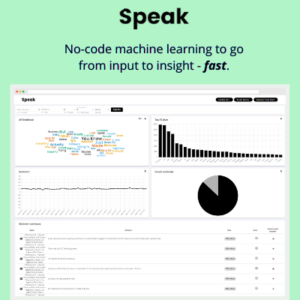
How to Transcribe a YouTube Video You don’t need to convert a YouTube video into mp4 to transcribe it. Simply upload the URL to Speak

How to Transcribe Audio and Video to Text in 2 Minutes (2022 Guide) Learn how to transcribe audio and video to text with Speak Ai

The Complete Guide to Text Analytics (2022) Text analytics (or text mining) refers to using natural language processing techniques to extract key insights from chunks

What is Natural Language Processing: The Definitive Guide Natural language processing is the large field of studying how computers can understand human language accurately, and
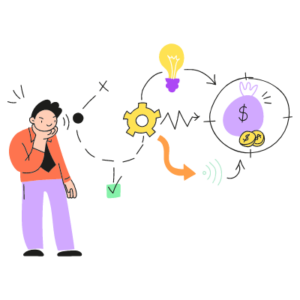
A Simple Guide on How to Do Market Research in 2021 Learn some simple steps to get you started on how to do market research,

Powered by Speak Ai Inc. Made in Canada with
Use Speak's powerful AI to transcribe, analyze, automate and produce incredible insights for you and your team.